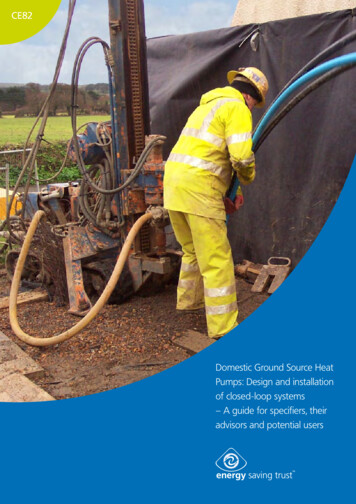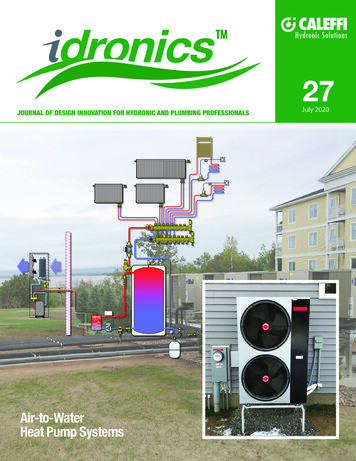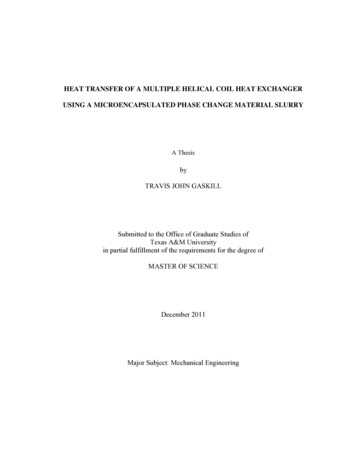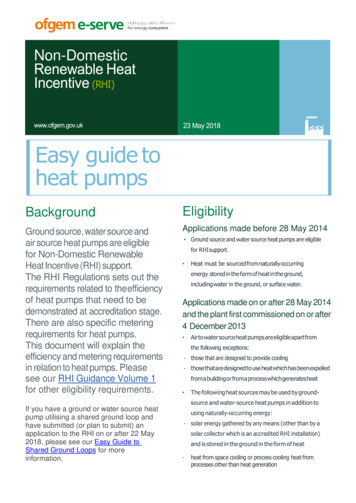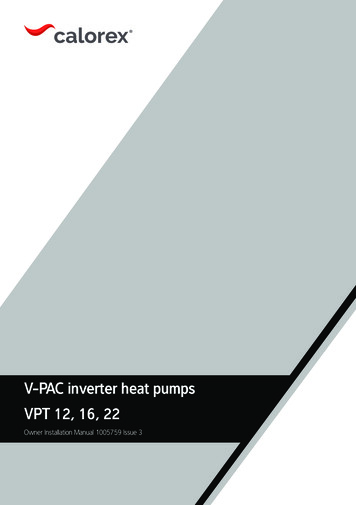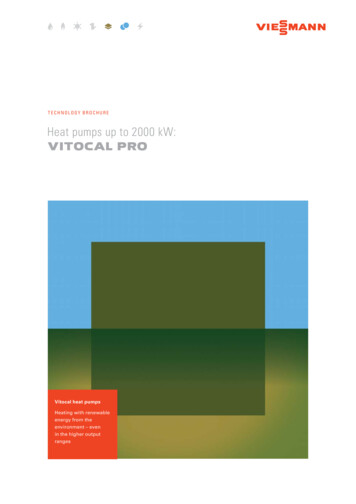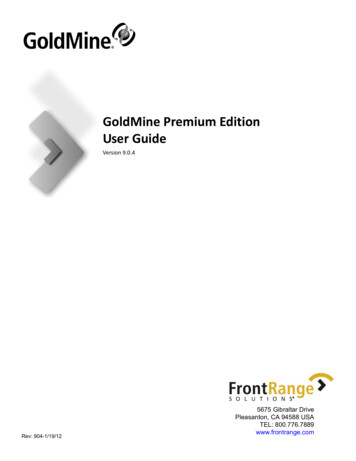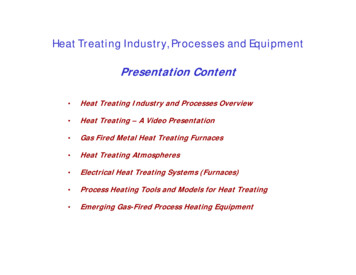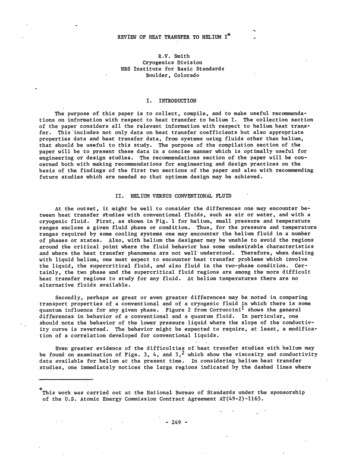
Transcription
1IIIIIIIIIIIIIIIIII.REVIEW OF HEAT TRANSFER TO HiZIUM I*.R.V. SmithCryogenics DivisionNBS Institute for Basic StandardsBoulder, ColoradoI. INTRODUCTIONThe purpose of this paper is to collect, compile, and to make useful recommendations on information with respect to heat transfer to helium I. The collection sectionof the paper considers all the relevant information with respect to helium heat tran,sfer. This’includes not only data on heat transfer coefficients but also appropriateproperties data and heat transfer data, from systems using fluids other than helium,that should be useful to this study. The purpose of the compilation section of thepaper will be to present these data in a concise manner which is optimally useful forengineering or design studies. .The recommendations section of the paper will be concerned both with making recommendations for engineering and design practices on thebasis,of the findings of the first two sections of the paper and also with recommendingfuture studies which are needed so that optimum design may be achieved.11.HELIUM VERSUS CONVENTIONAL F L U I DAt the outset, it might be well to consider the differences one may encounter between heat transfer studies with conventional fluids, such as air or water, and with a.cryogenicfluid. First, as shown in Fig. 1 for helium, small pressure and temperatureranges enclose a given fluid phase or condition. Thus, for the pressure and.temperatureranges required by some cooling systems one may encounter the helium fluid in a numberof phases or states. Also, with helium the designer may be unable to avoid the regionsaround the critical point where the fluid behavior has some undesirable characteristicsand where the heat transfer phenomena are not well. understood. Therefore, when dealingwith liquid helium, one must expect to encounter heat transfer problems which involve .the liquid, the supercritical fluid, and also fluid in the two-phase condition. Certainly, the two phase and the supercritical fluid regions are among the more difficultheat transfer regions to study for any fluid. At helium temperatures there are noalternative fluids available.Secondly, perhaps as great or even greater differences may be noted in comparingtransport properties of a conventional and of a cryogenic fluid in which there is somequantum influence for ahy given phase. Figure 2 from Corruccinil shows the generaldifferences in behavior of a conventional and a quantum fluid. In particular, oneshould note the behavior of the lower pressure liquid where the slope of the conductivity curve is reversed. The behavior might be expected to require, at least, a modification of a correlation developed for conventional liquids. .Even greater evidence of the difficulties of heat transfer studies with helium maybe found on examination of Figs. 3 , 4, and SY2 which show the viscosity and conductivitydata available for helium at the present time. In considering helium heat transferstudies, one immediately notices the large regions indicated by the dashed lines where*This work wascarried out at the National Bureau of Standards under the sponsorshipof the U.S. Atomic Energy Commission Contract Agreement AT(49-2)-1165.-249-
there are no reliable experimental or theoretical guides and where values for propertiesmust be considered to be crude 'estimates with a poor degree of reliability. Except fordata in the saturated region and in the vicinity of 1 atm, the reliability of the datashown by the solid lines is marginal for use in heat transfer studies. Figures 4a and5a show the data with constant-pressure parameters for engineering use. Thirdly, thevalues of the properties are relatively different from those of a conventional fluid.For example, at the normal boiling point the viscosity of water is about 100 times thatof helium, the specific heat about equal to that of helium, and the density about eighttimes as great. Therefore, in considering the conventional heat transfer correlationswhich involve Reynolds (uDp/v) and Prandtl (culk) numbers, one can quickly see that,with helium, quite different combinations of values of these dimensionless groups willbe encountered. Since the correlations themselves are not based on rigorous theory butare, indeed, primarily empirical relationships of dimensionless groups, the extensionsof these expressions into regions where the fluid properties differ by such a margincannot be justified without some experimental verification.In summary, with respect to transport properties, heat transfer studies are moredifficult because the properties vary significantly in value from those of conventionalfluids, and extrapolation of the correlations are not justified without experimentalverification. Further, the transport properties for the liquids behave 'quite differently from those of conventional fluids except at very high pressures, and the reliability of all of the properties data leaves a great deal to be desired in pursuing heattransfer studies. Finally, heat transfer studies with helium are substantially moredifficult than those dealing with conventional fluids because one.must deal with thedifficult regions for heat transfer with respect to phase changes and pseudo-phasechanges. The probkem is additionally complicated by marked differences in behaviorand in values of the transport properties from those of conventional fluids, and by apoor reliability of data for these transport properties.1IIIIIII111. DIVISION INTO REGIONS OF PHASE AND TRANSPORT PROPERTY BEHAVIORIn general, one might say that heat transfer phenomena are influenced by two setsof conditions. One set of conditions has to do with the physical properties and theother with the flow structure. With respect to the flow'structure, one is primarilyconcerned.with the behavior in the boundary layer. That is, one would first want toknow whether the boundary layer is laminar or turbulent and, if turbulent, the natureof the turbulence. Since the flow structure is very much a function of a specific system, it was decided not to make any divisions in this study with respect to this phenomenon. Therefore, the heat transfer study of helium will be divided into regions withrespect to the transport property and phase behavior, and the characteristics of theflow structure will be discussed in these regions where appropriate. The divisions areshown in Fig. 6.Region 1 and Region 2 differ from each other primarily because in Region 2 phaseseparation with equilibrium will be distinct whereas in Region 1 phase separation iseither not distinct or not possible. The liquid region and the gaseous region areRegions 3 and 4 , respectively.The line of maximum specific heats, which separates Region 1 from Region 4, isquite significant because, on the left of the line, one has what is often called apseudo-liquid. In this region then, quite close to the saturated liquid line or theline of.maximum specific heats, one does experience pressure and density oscillationsand other phenomena which are usually associated with the two-phase region.The data from which these curves were constructed may be seen in Fig. 7a.3InFig. 7a the constant-pressure lines show distinct peaks or humps in the specific heatbehavior for pressures reasonably close to the critical pressure. The maximum points-250-IIIEII
IIIIIIIIIIIIIIIIIIIo f t h e s e peaks c o n s t i t u t e t h e l o c u s of p o i n t s used t o c o n s t r u c t t h e maximum s p e c i f i ch e a t o r "transposed crit.ica1" curve. The dashed l i n e i n F i g . 6 r e p r e s e n t i n g t h i s cond i t i o n i s drawn w i t h s h o r t e r dashes as t h e p r e s s u r e i s i n c r e a s e d t o i n d i c a t e a weakertendency toward c r i t i c a l - p o i n t behavior. I n drawing t h e l i n e i n t h i s manner i t w a smeantt o show t h a t , as t h e peaking of t h e s p e c i f i c h e a t c u r v e became less d i s t i n c t ,.t h e l i n e , w h i l e s t i l l i n d i c a t i n g t h e maximum s p e c i f i c h e a t s , w a s r e c o r d i n g a phenomenonwhich was becoming less and less important. F l u i d i n c o n d i t i o n s f a l l i n g t o t h e l e f t of' t h i s maximum s p e c i f i c h e a t curve i s o f t e n c a l l e d a pseudo-liquid, w i t h f l u i d on t h eF u r t h e r twor i g h t of t h i s maximum s p e c i f i c h e a t curve s i m i l a r l y named a pseudo-gas.phase analogy i s s e e n i n F i g . 7 b Y 4 from which l a r g e d e n s i t y changes a s s o c i a t e d w i t h t h ec r o s s i n g of t h e transposed c r i t i c a l l i n e can be deduced.Looking a t t h e r e g i o n s from t h e p o i n t of view of h e a t t r a n s f e r knowledge o b t a i n e dfrom o t h e r f l u i d s , one might make some g e n e r a l s t a t e m e n t s a s t o t h e expected behaviorf o r each of t h e r e g i o n s s e l e c t e d . I n Region 4 , t h e . g a s r e g i o n , one would expect t h econventional c o r r e l a t i o n s t o be g e n e r a l l y e f f e c t i v e although some m o d i f i c a t i o n may ber e q u i r e d because o f t h e p r o p e r t i e s behavior p r e v i o u s l y d i s c u s s e d . I n Region 3 , t h el i q u i d r e g i o n , t h e p r o p e r t i e s behavior w i t h r e s p e c t t o t h a t of c o n v e n t i o n a l f l u i d s i sq u i t e d i f f e r e n t ; however, t h e conventional c o r r e l a t i o n s should s t i l l form t h e b a s i s bywhich one may make r e l i a b l e h e a t t r a n s f e r p r e d i c t i o n s . Heat t r a n s f e r phenomena i nRegion 2, t h e two-phase r e g i o n , i s not w e l l understood f o r any f l u i d . T h i s me.ans t h a talmost any e x t e n s i o n of t h e use of conventional e x p r e s s i o n s t o t h e heli.um r e g i o n shouldb e accompanied by a r a t h e r complete experimental v e r i f i c a t i o n i f any s u b s t a n t i a l r e l i a b i l i t y i s r e q u i r e d i n t h e use of t h e d a t a . I n Region 1 t h e pseudo-liquid o r s u p e r c r i t i c a l r e g i o n n e a r t h e l i n e of maximum s p e c i f i c h e a t s , . a poor understanding e x i s t s , a tb e s t , f o r t h e h e a t t r a n s f e r behavior. Here a g a i n , a good d e a l of experimental d a t a w i l lbe r e q u i r e d f o r helium i f r e l i a b l e h e a t t r a n s f e r p r e d i c t i o n s a r e t o be achieved.IV.l.IV.REGION 1 - SUPERCRITICAL NEAR THE TRANSPOSED CRITICAL LINERegion BoundariesR e f e r r i n g t o F i g . 6, .one may see t h a t . t h e b e s t d e f i n e d boundary f o r Region 1 i st h a t made by t h e l i n e of maximum s p e c i f i c h e a t s o r t h e transposed c r i t i c a l l i n e . Thet r a n s p o r t p r o p e r t i e s of v i s c o s i t y and c o n d u c t i v i t y are g e n e r a l l y b e l i e v e d t o go througha s i m i l a r peaking phenomenon a s shown i n F i g . 7a when t h e c r i t i c a l p o i n t i s approachedf o r any f l u i d . T h e r e f o r e , i t would be expected t h a t . c u r v e s s i m i l a r t o F i g . 7a couldbe g e n e r a t e d , f o r helium, f o r t h e t r a n s p o r t p r o p e r t i e s of c o n d u c t i v i t y and v i s c o s i t y .However, no e x p e r i m e n t a l d a t a have been generate! t o v e r i f y t h i s concept.The l e f t boundary of t h i s r e g i o n i s more d i f f i c u l t t o d e f i n e . It is meant t o d e s c r i b e t h e boundary such t h a t t h e f l u i d OR i t s l e f t shows no evidence of maxima singul a r i t i e s i n i t s p r o p e r t i e s nor a s s o c i a t e d . t e n d e n c i e s toward p r e s s u r e o s c i l l a t i o n s . Onemight conclude, t h e r e f o r e , : t h a t t h e l e f t boundary of t h i s r e g i o n should f a l l along ap r e s s u r e l i n e where t h e s p e c i f i c h e a t curve a s shown i n F i g . 7a no l o n g e r e x h i b i t s apeaking behavior o r t h e d e n s i t y curve shown i n F i g . 7b no l o n g e r h a s a s t e e p s l o p e .For helium, t h i s would appear t o be along a c o n s t a n t p r e s s u r e l i n e i n t h e r e g i o n ofroughly 15 atm.If might b e reasoned t h a t Region 1 should e x t e n t t o t h e r i g h t o f t h e transposedc r i t i c a l l i n e as w e l l a s t o t h e l e f t . T h i s a r e a i n c l u d e s t h e r i g h t h a l f of t h e p r o p e r t y"hump" behavior shown i n F i g . 7a. For t h i s paper, i t w a s decided n o t t o i n c l u d e t h i sa r e a i n Region 1 f o r two r e a s o n s . F i r s t , t h e s l o p e of t h e c u r v e s descr,ibing p r o p e r t ybehavior a r e less s t e e p on t h i s s i d e of t h e maxima. Secondly, almost a l l h e a t t r a n s f e rprocesses which seem l i k e l y w i t h helium i n v o l v e p r e s s u r e r e d u c t i o n . Consequently processes w i l l g e n e r a l l y r u n from l e f t t o r i g h t i n F i g . 6. T h e r e f o r e , t h e v a r i a b l e prope r t y r e g i o n i s u n l i k e l y t o be approached from t h e r i g h t of t h e t r a n s p o s e d c r i t i c a l l i n e .-251-
IThe lower boundary of the curve which extends across the liquid-vapor domealso reasonably difficult to define in a precise or distinct manner. The curvetended to form a boundary such that fluid which falls above the curve will haveerties, particularly density properties, for the liquid and the gas such that ation of the phases is fairly slow or difficult.IV.2.isis inpropsepara-Behavior of Conventional Fluids in Region 1In Region 1, the special problem encountered in the heat transfer analysis isthat of the fluid property, particularly the transport and density property, behaviorin the boundary layer. These variations are shown in Figs. 7a and 7b. If the walltemperature is above the transposed critical temperature for the fluid and the bulktemperature of the fluid below that value, some fluid in the boundary layer must be inRegion 1. This means that there will be widely varying values for the properties and,also, situations where some of the properties will go through maximum values within theboundary layer. Most heat transfer correlations assume the use of constant or effec-.tive property values. Correlations using this system are known to be ineffective forconditions where there are wide variations in the fluid boundary layers; This wouldoccur either when there are high temperature differences between the ball and the fluidor when there are large property variations with relatively small varsations in.temperature such as those conditions in Region 1.IV.2.1.OscillationsPerhaps the most important physical phenomenon which has been associated with thisregion has been that of pressure and flow oscillations. This behavior has been similarto that of a two-phase fluid. Some authors have chosen to label this as a boiling-likeor a pseudo-boiling region. Among these are Dickinson and Welch,5 Dubrovina andSkripovY6 and Griffith and Saber ky. One might very easily associate this phenomenonwith the presence of a heavy and light species in this region; however, this has notbeen completely experimentally documented at this time. Some understanding of theseoscillations has been obtained by the use of treatments that are modifications of rather conventional mechanics developed to describe specifically the oscillating systems. .That is, the fluid system has been treated as one'which is analogous to a more conventional oscillating system. Among those papers that have recently reported studiesprimarily dealing with oscillations in this re ion are the following: Hendricks et a1.8for hydrogen, Thurston et al.9 and Thurstonlo,fl for hydrogen, and Cornelius12 forFreon 114.IV.2.2.'IIIIIIIIII1ITemperature profiles in the boundary layerSome further insight into the behavior in the.fluid in this region may be obt'ainedby consideration of the temperature profiles one might expect to find in the boundarylayer. This was investigated by Wood and Smith13 using carbon dioxide. First of all,one does not expect to find these phenomena occurring except when the transposed critical temperature falls between the temperature of the wall and the temperature of thebulk of the fluid. When these conditions are met, then, of course, the extreme behavior of the fluid properties will be found in the region of the boundary layer.&st papers record that this special behavior indeed does occur only when these temperature conditions are met. Some further insight into the behavior of the temperatureprofiles in the boundary layer may be found by first considering the expression forturbulent heat transfer which is as follows:- 252 -IIII
IIIIIIIIIIIIIIIIIIIgradient that would exist if the boundary layer were completely laminar, while thegroup of terms in the parentheses represents .the coefficient of the gradient for theturbulent condition. Remembering that in all flow there is a laminar-like sublayer,one might speculate that, in this region where the conductivity term controls, andwhere this value will be expected to be enhanced generally, the resistance to heattransfer would be decreased and the temperature profile would be less steep than usualin this region. If the turbulent level or scale of turbulence is assumed to be essentially constant, then the resistance to heat transfer in this region will be inverselyproportional to the density times the specific heat. In examining the terms in thisregion one would generally expect the resistance to decrease. This is because the.specific heat would be expected to increase more rapidly than the compensating densitydecrease near the critical point.Another possible change in the heat transfer in this region might be brought aboutby a change in the level of turbulence shown by Eh' Such a change may be possible because the large density changes shown in Fig. 7b would create a rather large fluidacceleration. Under such circumstances the turbulent eddies might change such thatthe level of turbulence would be reduced.IV.2.3.Behavior of the heat transfer coefficientThen, looking at these two regions of the laminar sublayer and the turbulent core,one finds that the resistance.in the net is decreased in the laminar sublayer and inthe turbulent core so that the conventional temperature profile would be somewhat flattened for this heat transfer condition. Considering these circumstances alone, onemight expect the heat transfer in the net to be enhanced because of these changes inthis region. After the bulk temperature reaches the transposed critical temperature,however, the opposite would be expected to be true and one would.expect to find a degradation of the heat transfer rate. This is indicated by property behavior and confirmed by experiment.An example of this behavior of the heat transfer coefficient near the transposedcritical is shown in Figs. 8a and 8b as reported by Dubrovina and Skripov.6 Thesefigures show that the heat transfer coefficient follows the property behavior ratherclosely, with a substantial enhancement near the transposed critical and considerablylower values on either side. It should be noted, however, that Fig. 8b shows that theenhancement occurs only for very small temperature differences between the wall and thefluid.IV.3 .Analytical WorkFinally, one may consider the analytical work which has been reported to describethe heat transfer in this region. One may generally arrange this work into two sectionsdivided by the general method of approach which was used. One set of analyses has concexned itself with an integration through the boundary layer for the case of variablefluid properties. This method involves the use of universal parameters for.the flowvariables. A review of universal velocity distribution functions may be found inSpalding l4.Dei slerl has, presented a series of papers,employing this method. Figure 9shows the relationship between the temperature, Tx, at which properties are evaluatedto produce the proper relationship between the Nusselt number and the Reynolds numberfor supercritical water. These curves are for a Prandtl number of one. Of course,some function of the Prandtl number can be found to'bring the curves nearer to a singlecurve. One may also see that if the proper temperature, Tx, is chosen the same formof the conventional correlation which employs constant properties may be used.-253-
The other method of analyzing experimental data reported in this region is to .seek a satisfactory modifying parameter for the conventional correlations. In almostall the cases, this modifying parameter contains the ratio of the wall to bulk temperature or the ratio of properties which are primarily a function of this temperatureratio, such as kinematic viscosity. Thus,Nu 0.023'(Pr)Om4 (modifying parameter)where(modifying parameter) (T /T )(a)w bor f(vw/vb)where a is an exponent determined empirically.Hendricks et a1.17 show a ratio of the Nusselt number over a Nusselt number calculated by an analogous procedure to a two-phase Nusselt number correlated with theMartinelli and Nelson18 parameter as--NuNUcalc- f(Xtt)*Again, the correlations produced by this method have been shown to be superiorto those.simply using the conventional single-phase heat transfer correlations.Although the two methods of approach previously discussed appear to be quite different, .the resulting correlations are fairly similar in form. Some examples of thesepredictive correlations and their use follow:Bringer and Smith"Forced Convection COP (no humps)Nu 0.0266' (Re)(Pr) 0 55(Deissler 5,TxTXWood and Smith13 Forced Convection C02Enhanced near transposed criticalMiller et a1."and Miller"- Two resistance concept -Forced Convection H2 (no humps)0.8Nu 0.0204('0.4),(Pr)",:(1 0.00983 vW/vb)where the subscript indicates the location of the boundar layer temperature for theproperty evaluation as proposed by Deissler and Pressler2 and the modifying parameteris of the form proposed by Hess and K u n . IV.4. Helium I in Region 1Three papers have reported on s stems which involved heat transfer to supercritiBecausecal helium. These are: Kolm et al.? Klipping and K u t n e r ,and Brechna.'lithe actual boundaries of Region 1 are yet to be determined, it cannot be said whetheror not these data actually have fallen in what has been termed Region 1 for this paper.Additionally, all of these papers which do report data are handicapped because reliableproperty data are lacking in this general region for helium. Kolm et al.4 reports asystem using the supercritical helium I for heat transfer but does not report experimental heat transfer data. Klipping and KutznerZ4 report a study of heat transfer tosupercritical helium by free convection. The heated surface was a horizontal cylinder,- 254 -'IIIBIIIIIIIIIDIIIII
IIIIIIIIIIIIIIIIIIIe2 cm long and 0.4 cm in diameter. Since property data were not available, they re orted the data in a form as shown in Fig. 10. Here, one can see that, as Kolm et al.had previously suggested, heat transfer with supercritical helium is competitive withboiling heat transfer from other fluids and also with boiling heat transfer from helium. B r e h n ashows some results from forced convection heat transfer using superconductor cable material. These results indicate that the helium heat transfer inthis region is about 1.7 times that which would be expected using conventional singlephase heat transfer correlations. This work is also discussed for Region 3 .The very limited reported data for heat transfer to supercritical helium I do notallow any conclusions except that more work is certainly needed in this region. Foroptimum design of any system employing heat transfer to supercritical helium, one firstneeds the necessary transport property dat,a,and secondly, one needs reliable predictive heat transfer correlations for the fluid. It would appear that these correlationswill be modifications of the correlations applied to conventional fluids. Additionally,the boundaries of Region 1 need to be defined rather specifically. This is particularlyimportant with respect to pressure and temperature,oscillations. In heat transfer tocool superconductors, stability is much more important than in ordinary heat transfersituations. Therefore, the unstable regions where pressure oscillations might occurwith supercritical helium need to be well defined.V.REGION 2- TWO-PHASE, BOILING HEAT TRANSFER REGIONThe accepted divisions of boiling studies into that of poo1,boilingand forcedconvection boiling will be made.V.l.V.l.l.Pool BoilingBoundaries of regionsThe boundaries of this region seem reasonably well defined. Referring again toFig. 6, the left boundary is in the vicinity of a liquid-vapor saturation line. Somefurther discussion of the point of inception of bubbles will be carried out in the subsequent examination of the boiling curves. The lower limit of the region is in thevicinity of the lambda line. The right hand division of the region is distinct, as thevapor saturation line. Finally, the upper limit of the region has been discussed previously since it forms the boundary of the lower part of Region 1.V.1.2.Behavior of conventional fluids- poolboilingThe'general boiling curve exhibited for all fluids may be divided into four sections of study. These are:TheTheTheThenucleate boiling curve.maximum nucleate boiling flux.film boiling curve.minimum film boiling flux.Following the pattern set in Region 1, the behavior of other fluids in these variousboiling divisions will be discussed first. This will allow some insight into thepeculiarities of helium boiling and allow estimates for helium behavior where data'have not been previously obtained or have been obtained in very small quantitias without the confirmation of subsequent studies.-255-
V.1.2.1.IINucleate boilingTypical nucleate boiling curves may be se'err in Figs. 11, 13, and 14. The lowerportion of the curve is defined by the inception of the formation of bubbles and on aplot such as in Figs. 13 and 14 where the heat transfer per unit area is plottedagainst the temperature difference between the bulk of the fluid and its surface, theinception of bubbles causes a sharp rise in the slope of the curves. This slope remains generally constant on'such a plot and is proportional to about the third.powerof the temperature difference. The analytical curves then developed to express thenucleate boiling phenomena will be of the general formq / A f(properties) (TwTsatl3It seems reasonably well established at this time that, in many cases, the multiplierof the temperature difference is a function of the heated surface as well as the fluid.This aspect of boiling will be discussed in a later section.A number of nucleate boiling curves, evaluated for hydrogen.at 1 atm, are shownin Fig. 11 along with the regions of reported experimental data. In general, the correlations are dependent upon fluid properties alone, and that will be the basis onwhich these curves will be discussed. The state of knowledge regarding the boilingphenomena has not advanced to the point where the primary or controlling influencesin the process have been established in a manner generally accepted as that one whichis correct. Therefore, all of the correlations may be said to owe some of their development to dimensional or similarity concepts. A number of the correlations that havebeen more recently proposed involve the number of nucleation sites. Since these data.are not generally available on an engineering or design basis, these correlations arenot yet useful for design use. In a revious report on boiling of cryogenic fluids byBrentari and Smith,26 the Kutateladzeg7 correlation was recommended as one that represented the behavior of hydrogen reasonably well. Obviously, from an examination ofFig. 11, one can see that several other correlations could be said to represent thedata with equal reliability. The general requirements for a successful correlationare to express the properties data in such a way that the curve will have a point withthe approximately correct horizontal location and then from that point have the slopeexpressed as about the third power of a temperature difference. Since the Kutateladzecorrelation is reasonably successful for the cryogenic fluids it will be used as areference in the subsequent discussion of helium boiling. This expression is'(3)V.1.2.2.Maximum nucleate boiling fluxAs the temperature of the heated surface is increased during nucleate boiling a. point is reached where the nucleate boiling curve essentially becomes discontinuous.Physically, this might be very roughly visualized as the point at which the vapor removal. procedure during the boiling becomes such that a wetting cycle during that process is no longer possible. The boiling is then said to enter the film boiling regimewhere essentially a vapor film is maintained between the heated surface and the bulkof the liquid. This point is almost always associated with a very rapid increase inthe temperature of the heated surface. The point is of particular interest to many- 256 -IIIIIIIIIII
IIIIIIIEIII1IIIIIIIdesign situations because, very often, if this condition is allowed to occur, it willresult in the system’s failure. This would almost certainly be the case for a heliumcooled superconductor. In separate studies, both Kutateladze’’ and Zuber28 have produced expressions which are reasonably successful in predicting this maximum flux.This expression is as follows:(4)Again, it will be noted that this expression is a function of a fluid properties,aloqeand not of the relationship between the fluid and the boiling surface conditions’or ofthe surface conditions. Deviations which may occur as a result of the surface conditions will be discussed subsequently in this section. It should be pointed out thatalthough the maximum heat flux can be predicted to a reasonable degree of accuracy, thetemperature difference at which this flux will occur is much more
tween heat transfer studies with conventional fluids, such as air or water, and with a .cryogenic fluid. First, as shown in Fig. 1 for helium, small pressure and temperature . heat transfer regions to study for any fluid. At helium temperatures there are no alternative fluids available. Thus, for the pressure and.temperature


